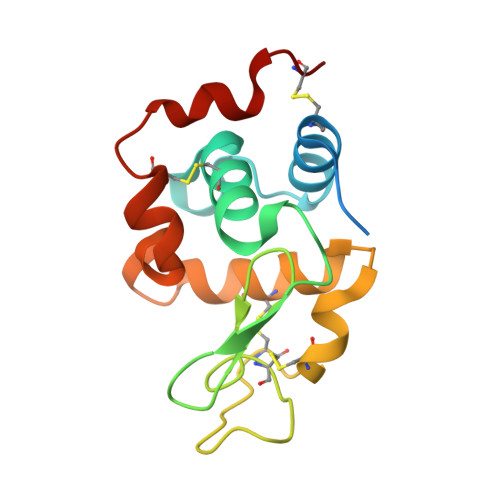Cryogenic X-ray crystallographic studies of biomacromolecules at Turkish Light Source " Turkish DeLight ".
Atalay, N., Akcan, E.K., Gul, M., Ayan, E., Destan, E., Ertem, F.B., Tokay, N., Cakilkaya, B., Nergiz, Z., Karakadioglu, G., Kepceoglu, A., Yapici, I., Tosun, B., Baldir, N., Yildirim, G., Johnson, J.A., Guven, O., Shafiei, A., Arslan, N.E., Yilmaz, M., Kulakman, C., Paydos, S.S., Cinal, Z.S., Sabanoglu, K., Pazarceviren, A., Yilmaz, A., Canbay, B., Asci, B., Kartal, E., Tavli, S., Caliseki, M., Goc, G., Mermer, A., Yesilay, G., Altuntas, S., Tateishi, H., Otsuka, M., Fujita, M., Tekin, S., Ciftci, H., Durdagi, S., Dinler Doganay, G., Karaca, E., Kaplan Turkoz, B., Kabasakal, B.V., Kati, A., Demirci, H.(2023) Turk J Biol 47: 1-13
- PubMed: 37529114
- DOI: https://doi.org/10.55730/1300-0152.2637
- Primary Citation of Related Structures:
7Y6A - PubMed Abstract:
X-ray crystallography is a robust and powerful structural biology technique that provides high-resolution atomic structures of biomacromolecules. Scientists use this technique to unravel mechanistic and structural details of biological macromolecules (e.g., proteins, nucleic acids, protein complexes, protein-nucleic acid complexes, or large biological compartments). Since its inception, single-crystal cryocrystallography has never been performed in Türkiye due to the lack of a single-crystal X-ray diffractometer. The X-ray diffraction facility recently established at the University of Health Sciences, İstanbul, Türkiye will enable Turkish and international researchers to easily perform high-resolution structural analysis of biomacromolecules from single crystals. Here, we describe the technical and practical outlook of a state-of-the-art home-source X-ray, using lysozyme as a model protein. The methods and practice described in this article can be applied to any biological sample for structural studies. Therefore, this article will be a valuable practical guide from sample preparation to data analysis.
- Department of Molecular Biology and Genetics, Faculty of Science, Koç University, İstanbul, Türkiye.
Organizational Affiliation:

















